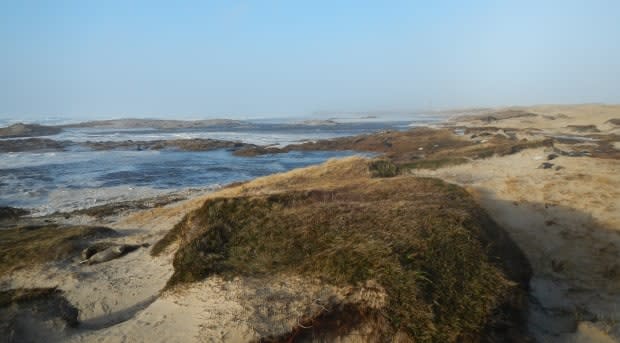Sable Island undergoing dramatic coastline retreat

New research shows portions of Sable Island have shrunk dramatically in recent decades — at times by ten metres per year on the south side, where several freshwater ponds and a lake disappeared entirely amid storm surge, shifting sands and sea level rise.
Using aerial photos going back to 1959, researchers tracked the movement of the coastline and used that data to model what will happen to the island by 2039.
The study in Canadian Journal of Earth Sciences predicts a further loss of 10 hectares of vegetated areas by 2039 (less than one percent of the Island) with the island core remaining intact and some growth on the northern shore.
It concludes the narrow 42 kilometre-long crescent shaped sandbar located 160 kilometres off the coast of Nova Scotia is slowly shrinking, likely due to ongoing and accelerating sea-level rise.
"Projections indicate that South Beach is retreating faster than North Beach is advancing, which would result in an increasingly narrow overwash area possibly resulting in breaches and reduced island connectivity," the study states.
Climate change caveat
The paper's predictions are based on the current rate of sea-level rise, not projected rise, which is forecast to double by 2100 because of climate change.
"Climate change is resulting in accelerated local sea-level rise and changes in storm patterns and intensities that suggest these results should be treated as a baseline for future changes to Sable Island," the report says.

Still, lead author Jordan Eamer of the Geological Survey of Canada said the island has proven resilient despite "really dramatic changes that can occur on a very short time scale."
"I looked at the data and at areas where I thought we would see a lot of erosion or a lot of change and it looked fairly stable, a lot of migration, a lot of movement. But that's kind of what you want. You don't want it to be a stable rock or a stable treed island, because once you lose that, it's gone. This is a dynamic place that seems to be reacting to the changes."
The south beach retreat
The most dramatic change is occurring on the south beach in the centre-west part of Sable Island, which is exposed to prevailing weather patterns.
"Over the last 60 years we saw periods where there was at least 10 meters per year of shoreline retreat, which is pretty significant considering there's lots of infrastructure. A lot of freshwater ponds. Hotspots of biodiversity," Eamer said.

"And where we saw that really dramatic retreat of the beach, that protective foredune was essentially lost. And then a big significant area that hosted freshwater ponds basically got over washed. It saw windblown sand being deposited in the ponds itself and it is largely a sand plain today."
What happened when a weather bomb hit Sable Island
When the open ocean rolls into and over Sable Island the results are spectacular and a bit scary.
Eamer witnessed one of these events on Jan. 5, 2018 when a "weather bomb" landed with swells on both the north and south side, overtopping dunes and surging through parts of the island.
Working for Parks Canada at the time, he captured a roadway transformed into a racing river of seawater on video.
"I can tell you being on the island when that happened, the island felt very small. I really expected to see the island disappearing after a storm like that. This was before the study. It seemed like just in a snapshot it can erode. But within weeks areas that looked dire, looked really eroded, were rebuilding," he said.
What happens to freshwater table
The study notes the risk posed by inundations to the freshwater table which supports a crew of researchers, occasional Parks Canada visitors and a resident population of over 550 horses.
When a large storm hits the island, seawater can flood areas. Water will pool and filter down through the sands and salinize portions of the freshwater aquifer below.
Julia Cantelon, a PhD student studying coastal hydrology at Dalhousie University, monitored the impact of hurricane Dorian in 2019 and tropical storm Reddy in 2020 on low-lying areas of Sable Island.

"I was able to see the groundwater level increase when it flooded quite rapidly. And then within an hour of that the groundwater was completely saline seawater concentration," Cantelon said.
She added the groundwater still has not fully recovered to freshwater in these areas.
Still, she said while vulnerable, the freshwater table is resilient.
Salination is localised and not island-wide after a big storm.
The big unknown
Eamer is hopeful, but does not offer an opinion on whether the island can withstand the climate change forecast that could result in sea level rise in the North Atlantic by 80 centimetres — or nearly a metre — over the next 80 years.
"That has significant implications for what is going to get over washed and where that water is going to go on the island," Eamer said.
A key question is whether the dune system can respond to changing sea levels.
"It's a pretty big unknown, what that means going forward. A lot of questions to be asked. But generally the theory is that beaches and dunes can react to sea level rise if you give them enough room to and you have enough sand around for them to to feed on."
Sable Island formed after the last ice age when water levels on the Atlantic coast were considerably lower.
It was likely 10 to 15 times larger than it is today.
"So, while the changes are very dramatic and I'm not downplaying those, the island has done a lot of changes through its life," Eamer said.
MORE TOP STORIES

 Yahoo Movies
Yahoo Movies 